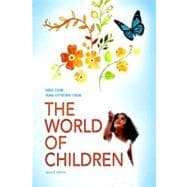For the undergraduate child development course taught chronologically.
The World of Children is a chronological child development textbook by Joan Littlefield Cook and Greg Cook that helps students connect the science and the practice of child development in a way that can positively change lives. This exciting new text features an active learning system that exposes students to real people facing real world child development challenges, and encourages them to think critically about issues from multiple perspectives.
The World of Children demonstrates the practical applications of child development through interviews with a diverse group of real parents and a variety of professionals who rely upon child development information in their jobs. Each chapter also spotlights the ways programs, laws, regulations, and other governing aspects of society can affect children.
Looking for additional resources to help you understand the material and succeed in this course? MyDevelopmentLab contains study tools such as flashcards, self tests, videos, as well as MyVirtualChild which allows you to raise your own virtual child from birth through age 18 and monitor the results.
Want to learn more about MyVirtualChild? Visit www.mydevelopmentlab.com and click on the ‘watch this video’ link to learn about MyVirtualChild.
MyDevelpmentLab with MyVirtualChild is available at www.mydevelopmentlab.com.








